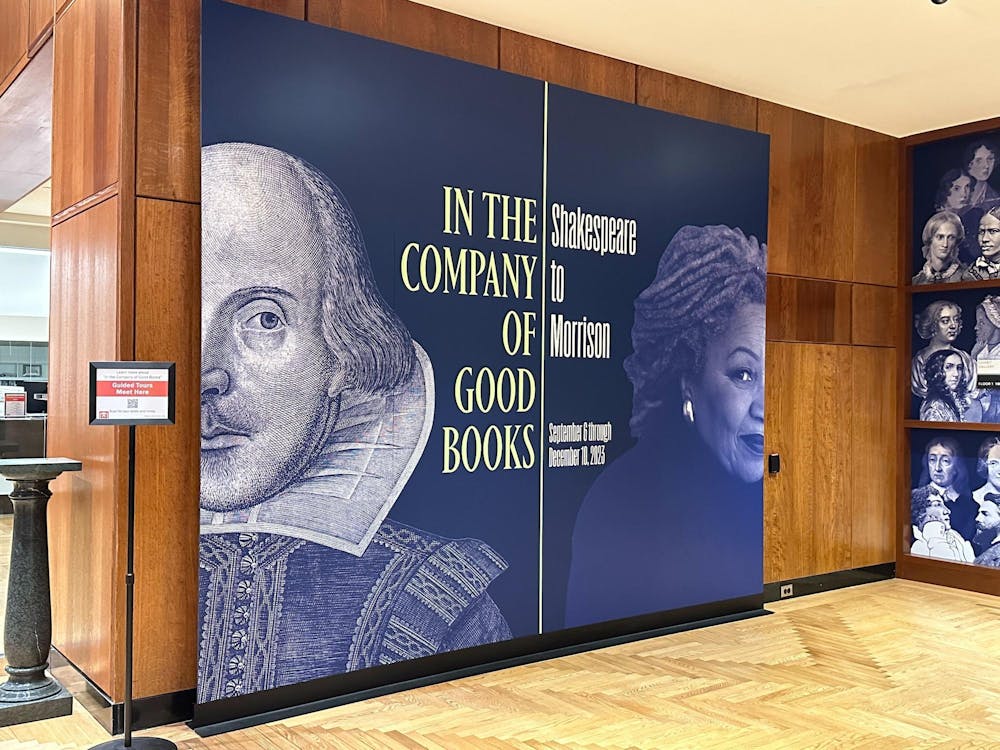This year marks the 400th anniversary of the publication of William Shakespeare’s “First Folio.” Produced seven years after his death, the First Folio was the first published collection of Shakespeare’s plays, serving as an essential compilation of 36 works in their complete text.
In honor of this anniversary, the Princeton University Library’s Milberg Gallery presents “In the Company of Good Books: Shakespeare to Morrison.” It’s an exhibition that celebrates the continuous conversation between various authors and their works throughout the decades, showcasing Princeton’s sprawling collection of English literature.
The exhibition begins with Shakespeare and progresses chronologically, moving “into time.” The first display case holds three rare copies of Shakespeare’s “First Folio,” including the first copy to ever make it into North America. This special folio also contains signatures by various scholars, playwrights, and actors; it was customary for the author of a folio to keep it for a period of time and then pass it on to others. This tradition reflects a central idea of the exhibition: writers converse among themselves and across generations, with Shakespeare’s work continuing to influence and inspire authors to this day.
This idea develops further throughout the exhibit in earlier examples like the influence of John Milton’s 17th-century epic poem “Paradise Lost” on Mary Shelley’s “Frankenstein,” to more contemporary examples, such as letters between Ralph Waldo Emerson and Walt Whitman and ideas exchanged by authors of color in the 20th century. The latter is spotlighted in a display that features Toni Morrison’s copy of “Uncle Tom’s Cabin,” its margins annotated in bright red ink, and James Baldwin’s copy of Lorraine Hansberry’s play “A Raisin in the Sun,” whose title derives from Langston Hughes’ poem, “Harlem.” The exhibit reveals a sprawling network of connections and relationships between different writers and the themes they examine in their respective works.
There’s an intimacy to the handwritten, unfinished nature of the manuscripts featured: it’s a tangible record of writers developing their craft. One display holds juvenilia by the Brontë sisters — tiny inscriptions on wax paper from wrappers — evidence of how many female writers of the time educated themselves at home. Another display featuring Morrison’s manuscripts includes alternate endings to her novel “Beloved,” a signed page from when her apartment caught fire, and circled and crossed-out early drafts in pencil — a peek into her writing process. Poets Phillis Wheatley and Elizabeth Barrett Browning’s works are spotlighted as well, demonstrating how many female writers of their time borrowed ancient ideas and used literature as a form of escapism.
The exhibition takes care to reflect on how various mediums and the art of publishing have been important elements in creating and reading literature. One case holds a stack of thin volumes of Harriet Beecher Stowe’s “Uncle Tom’s Cabin” in its original serialized format, which would have served to keep the readers engaged with each installment and provide revenue for Stowe. Chicago poet Gwendolynn Brooks used broadsides — large, one-sided posters — to share her poetry with the masses. These posters were mass-produced and placed in barbershops and churches; one such broadside, featuring her poem “We Real Cool,” hangs on the exhibition wall.
Two independent publishing ventures are noted by the exhibition as instrumental in shaping modern literature. One is Sylvia Beach’s Paris bookshop Shakespeare and Company; the original store sign is mounted on the wall of the exhibit. The bookshop hosted readings by authors, a lending library, and later a publishing office, and became a center for literary life. Especially striking is a rack of library cards, including one that records what Ernest Hemingway was reading from 1925 to 1938. The other enterprise is the Hogarth Press, established by Virginia and Leonard Woolf, which they hoped would allow them to publish works of literary merit that did not appeal to a wider public. One copy of a book printed by the Hogarth Press includes an off-center woodblock print that overlaps with the type — an endearing reminder of the novice state of the press when they began.
One of the final displays is dedicated to contemporary writing by authors in areas where the British empire had influence, such as former colonies. Many of the authors challenged the ideas they were brought up with, dealing with questions of power and assimilation in their writing. These authors were also in conversation with one another: William Butler Yeats’ poem “The Second Coming,” written during the Irish War of Independence, lends a phrase to the title of Chinua Achebe’s Nigeria-set novel “Things Fall Apart,” exploring the consequences of colonialism on language and culture.

The exhibition ends with a callback to Shakespeare, again highlighting the ongoing conversation that occurs when writers today read and respond to his works. The last display centers on a story involving Morrison: in response to her friend, theater director Peter Sellars’s claimthat “Othello” had lost significance over time, Morrison sought to write a play named “Desdemona” to maintain that Shakespeare’s play still held valuable insight. Her goal was to elevate the previously largely voiceless character of Othello’s wife to the forefront. The display contains early manuscript drafts of “Desdemona,” where Morrison reimagines Desdemona as a fully articulated character, crafting the story of her girlhood and an afterlife and bringing Shakespeare’s character into a bolder, modern context. It’s a fitting final element for an exhibition honoring the ever-evolving nature of the literary world.
“In the Company of Good Books: Shakespeare to Morrison” is open until Dec. 10, 2023.
Ivy Chen is a first-year and a contributing writer for The Prospect from Naperville, Illinois. She can be reached at iychen@princeton.edu.









